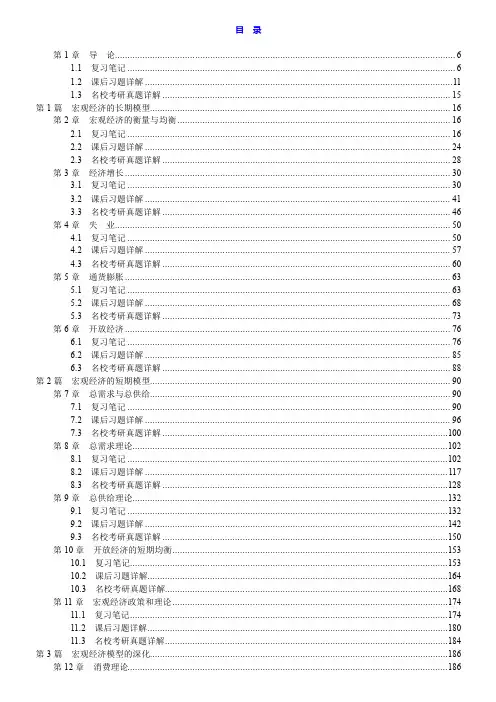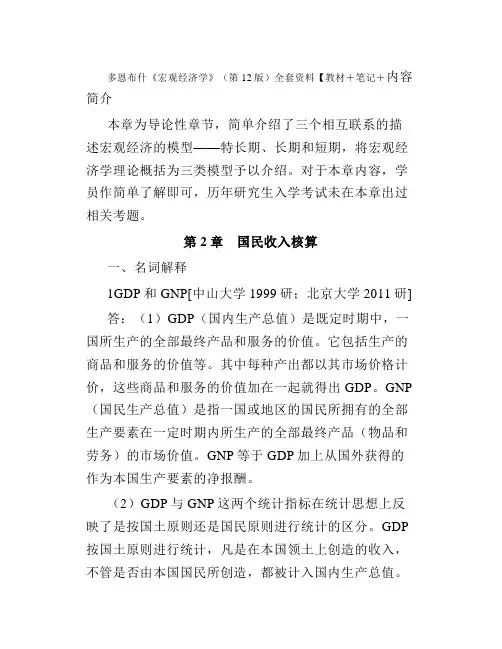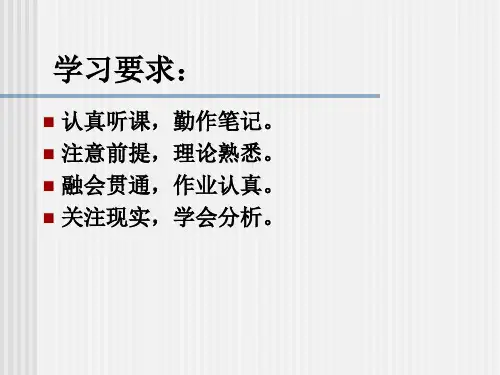宏观经济学教辅资料 (4)
- 格式:doc
- 大小:44.50 KB
- 文档页数:5





多恩布什《宏观经济学》(第12版)全套资料【教材+笔记+内容简介本章为导论性章节,简单介绍了三个相互联系的描述宏观经济的模型——特长期、长期和短期,将宏观经济学理论概括为三类模型予以介绍。
对于本章内容,学员作简单了解即可,历年研究生入学考试未在本章出过相关考题。
第2章国民收入核算一、名词解释1GDP和GNP[中山大学1999研;北京大学2011研]答:(1)GDP(国内生产总值)是既定时期中,一国所生产的全部最终产品和服务的价值。
它包括生产的商品和服务的价值等。
其中每种产出都以其市场价格计价,这些商品和服务的价值加在一起就得出GDP。
GNP (国民生产总值)是指一国或地区的国民所拥有的全部生产要素在一定时期内所生产的全部最终产品(物品和劳务)的市场价值。
GNP等于GDP加上从国外获得的作为本国生产要素的净报酬。
(2)GDP与GNP这两个统计指标在统计思想上反映了是按国土原则还是国民原则进行统计的区分。
GDP 按国土原则进行统计,凡是在本国领土上创造的收入,不管是否由本国国民所创造,都被计入国内生产总值。
GNP按国民原则进行统计,凡是本国国民收入,不管生产要素是否在国内,都被计入国民生产总值。
(3)国外要素支付净额(NFP)是指本国生产要素在世界其他国家获得的收入减去本国付给外国生产要素在本国获得的收入。
因此,国内生产总值就可以通过国民生产总值减去国外要素支付净额获得:GDP=GNP-NFP。
2名义GDP[中山大学2002研]答:名义GDP指在既定时期中,以该时期的价格计价的,或者有时表示为以现值美元计价的最终产品的价值,即用生产物品和劳务的当年价格计算的全部最终产品的市场价值,它没有考虑通货膨胀因素。
由于通货膨胀等原因,价格可能会发生强烈变化,故为方便比较而引入实际GDP的概念。
实际GDP是指用从前某一年的价格作为基期价格计算出来的当年全部最终产品的市场价值。
二者之间的关系式为:实际GDP=名义GDP÷GDP平减指数。




pptx目录•宏观经济学概述•国民收入与经济增长•货币银行体系与货币政策传导机制•财政政策与政府支出乘数效应•国际经济关系与汇率制度选择•总需求-总供给模型与宏观经济政策效果•开放经济条件下宏观经济政策协调•经济增长理论及其在中国实践应用宏观经济学概述宏观经济学研究对象与特点研究对象特点总量分析,关注经济总体的变化趋势和规律;政策导向,为政府制定经济政策提供理论依据。
宏观经济学与微观经济学关系相互联系区别宏观经济学发展历程及主要流派发展历程主要流派国民收入与经济增长国民收入核算体系介绍010203国民收入定义与分类核算方法与数据来源国民收入核算的意义经济增长理论包括古典经济增长理论、新古典经济增长理论和内生增长理论等,探讨经济增长的源泉、机制和影响因素。
经济增长政策实践包括财政政策、货币政策、产业政策和科技创新政策等,通过调节总需求、优化资源配置、提高生产效率等手段促进经济增长。
经济增长与可持续发展经济增长应注重可持续性,避免资源过度消耗和环境破坏,实现经济、社会和环境的协调发展。
经济增长理论与政策实践失业、通货膨胀与货币政策目标失业类型与原因通货膨胀类型与影响平下降等。
货币政策目标与工具货币银行体系与货币政策传导机制货币银行体系定义由中央银行、商业银行、其他金融机构及金融市场组成的复杂系统。
中央银行职能发行货币、制定货币政策、维护金融稳定、提供金融服务。
商业银行作用吸收存款、发放贷款、办理结算等业务,是货币政策传导的重要渠道。
其他金融机构与金融市场保险公司、证券公司、信托公司等,提供多样化金融服务,促进资金融通。
货币银行体系概述及功能货币政策工具及其运用策略货币政策工具种类存款准备金率、利率、公开市场操作等。
存款准备金率调整策略通过调整存款准备金率,影响商业银行信贷规模,进而调控货币供应量。
利率政策运用通过调整存贷款利率,影响居民储蓄和企业投资,达到调控经济的目的。
公开市场操作方式中央银行在公开市场上买卖国债等有价证券,调节市场流动性。


Chapter4:Working With The Solow Growth ModelChapter Summary:Chapter3introduced the basic neoclassical model of economic growth and its major results:growth rates tend to diminish over time as the economy approaches a steady state level of output per worker.Now the parameters of the model are manipulated to show how changes in the key parameters affect growth rates and the steady state level of ing the key equation describing the accumulation of capital,changes in savings rates,population growth rates or the labor force,and technology are analyzed.The steady state level of output per worker is shown to increase as savings rates or technology increase.The steady state level of output per worker falls as the population or grows.Changes to the labor force can affect the growth rate because they change the capital labor ratio,but they do not affect the ultimate steady state level of output per worker.In all of these cases,the curves in the basic steady state diagram are shifted to illustrate the effects of changing parameter values on the steady state level of capital.The concept of absolute convergence is examined next.Since the rate of capital accumulation per worker is essentially determined by the current stock of capital per worker,lesser developed countries are predicted by the model to grow more quickly than developed countries.However,the capital per worker will only generate faster growth rates if the values of the other parameters (savings,technology,population growth,etc.)are somewhat comparable.This implies that there is only conditional convergence.The empirical evidence presented in the chapter confirms this view.Data from more than100countries suggest that conditional convergence exists,but there is little evidence to confirm the existence of absolute convergence.Outline:I.Working With The Solow ModelA.A Change in the Savings RateB.A Change in the Technology LevelC.Changes in Labor InputD.Changes in the Population Growth RateII.ConvergenceA.Absolute ConvergenceB.Facts About ConvergenceC.Conditional ConvergenceIII.Appendix:The Speed of ConvergenceTeaching Tips:1.If the students are familiar by this point with the equation for growth in the capital stock(equation3.16)and the diagram which illustrates it,the diagrams provide clear predictions for the effects of changing parameter values.Each diagram should be accompanied by an intuitive explanation for the result as well.2.In many countries in Europe,birthrates have fallen below the replacement rate,as seen in the data below.The Solow model suggests that this should generate increasing productivity and a higher steady state level of income. However,the low birthrates have instead caused public concern and even government intervention(in the form of tax benefits for larger families and subsidized child care for working mothers).Clearly there is more to the population story than the simple Solow model indicates.The problem here is that the labor force participation rate is not constant.As the population ages,the labor force participation rate decreases.This puts their generous social pension and health care systems at risk.Also,though a falling labor force may increase the average product of labor,the total product of labor will clearly fall,and the average living standard of retirees along with it.Here are some statistics for European fertility rates(2.1children per woman is the replacement rate):Ireland:1.99France:1.90Norway:1.81Sweden1.75UK:1.74Netherlands:1.73Germany:1.37Italy:1.33Spain:1.32Greece:1.29Source:Eurostat-2004figures3.The section on Malthus(Extending the Model,pg.79)provides fascinating reading,but it would be a mistake to understand it as a historical argument long since discarded.The ideas of Malthus have had a revival as the environmental movement has grown over the last few decades.Although land may no longer be a limiting factor,the attention has now shifted to such things as climate change and fossil fuel consumption.A relatively recent example of this is Jared Diamond’s book,“collapse”.4.Is it right to consider people just another mouth to feed?The late economist Julian Simon made the opposite point-that individual creativity is“the ultimate resource.”Every mind produces new ideas that make every other minds more productive.How would this idea change the way we think about“n”in our model?5.The Solow model presented here is used to conduct positive economic analysis–this causes that.But there are important public policy issues associated with the theory.If the theory is accurate,should the government take design policies to influence parameter values?The one-child policy in China is one example,a sales tax to discourage consumption and encourage savings is another.Answers to Review Questions(pg.90):1:Recall that the saving curve in figure4.4depends on the average product of capital per worker:y/k,and that y depends only on output per worker,not the absolute level of labor or capital(see equation3.2on page49).Therefore,the level of saving depends only on the capital labor ratio;changes in the absolute levels of K or L do not shift the curve.Constant returns to scale is a key assumption here because it was used to derive equation3.2.Given Y=A*F(K,L) and constant returns to scale,multiplying Y by1/L yields:Y/L=A*F(K/L,L/L)or y=A*f(k).If constant returns to scale were not found,the output per worker would depend on the absolute sizes of K and L,and not merely the ratio between them.2.An increase in n will increase the rate at which capital per worker is depleted over time.This is illustrated on the graph by an upward shift in the horizontal line(as in figure4.6.)For any given savings rate,this will result in a lower steady state level of capital and output per worker.However,the absolute levelof output will continue to increase.An economy with a faster rate of population growth will grow more quickly after reaching its steady state.3.Convergence,as used in the theory of economic growth,refers to the tendency of less developed economies to grow more quickly than more mature economies. The theory is based on the idea that the growth rate will slow as an economy approaches the steady state level of capital per worker.Absolute convergence predicts that poor countries will grow more quickly regardless of their eventual steady state level of output.Conditional convergence predicts this pattern only if the countries have similar steady state levels of output.This would require, among other things,that the countries have similar technology,savings rates, and population growth rates.4.The Solow model does not predict that all countries must reach the same steady state.If it did,then the results in figure.4.9would be problematic.As it is,the model includes various determinants of the steady state level of output which may vary from country to country.The theory of conditional convergence suggests that relatively poor countries will tend to“catch up”over time to countries with similar savings rates,population growth,and technology. Answers to Problems for Discussion(pg.90)5.a.Yes,the growth rate in capital at any given period will depend on thesavings rate in that period.However,the idea that the economy approachesa steady state level of per-capita income cannot be assumed.b.A pattern of rising savings rates would offset to some extent the effects ofdiminishing returns and depreciation on capital accumulation.The increase in the savings rate could cause the growth rate to increase over time.This would reduce the tendency toward convergence.c.A tendency for savings rates to fall at higher levels of income wouldreinforce the effects of diminishing returns and capital depreciation oncapital accumulation;this would increase the tendency towardconvergence.d.A small increase in the level of consumption in the present when someoneis poor is likely to provide a higher rate of marginal utility than a similarincrease when they are rich,due to diminishing marginal utility ofconsumption.Therefore,it may seem more likely that a poor person wouldsave less than a wealthy person with similar preferences.This is the basis for the well known prediction that the marginal propensity to consume falls as income rises.However,this is complicated by the fact that the rate ofreturn on savings should be higher when capital is relatively scarce;thiswould provide a relatively strong incentive to invest in capital poorcountries.So for example,we observe that savings rates in China,which is still a relatively less developed country,are much higher than in the U.S.6. a.It is valid for each period,however,the idea that the economy approachesa steady state level of per-capita income cannot be assumed.b.A pattern of falling population growth would offset to some extent theeffects of diminishing returns and depreciation on capital accumulation.The increase in the rate of capital accumulation could cause the growth rate of output per person to increase over time.This would reduce the tendency toward convergence.c.A tendency for population growth rates to increase would have theopposite effect demonstrated in part b above.The rising population growth would reinforce the effects of diminishing returns and capital depreciation on capital per worker;this would increase the tendency towardconvergence.d.Malthus predicted that population growth rates would increase as afunction of income per worker,because it was excess population in hismodel which caused population growth to cease;in his view,it wasmortality rates associated with poverty.That poverty was the result ofdiminishing returns to agricultural land,which could not be accumulated after a certain point.However,in the steady state conceived by Malthus, income per capita reaches its lowest possible point,and it is notdepreciation of capital,but a decrease in the population growth that enables people to maintain even that miserable level of income.However muchMalthus’s model might have made sense at one point in human history,it is totally contradicted by the modern world.Today,the major resource iscapital rather than land,and we observe that population growth ratesdecline as per capita income rises.This is primarily due to the fact that birth rates seem to be inversely related to per-capita income.Therefore,case b seems more plausible in a modern industrial economy.。
《宏观经济学》课程考前辅导资料第一部考试复习所用教材《西方经济学(第二版宏观经济学部分)》刘凤良主编中国人民大学出版社第二部考试相关概念、知识点归纳一、相关概念:1.宏观经济学(Macroeconomics)是从宏观角度总体分析经济规律的的一个经济学领域,它主要研究经济整体资源的利用问题。
宏观经济学一般又称为总量经济学,即它研究生产的总量和消费的总量,以及如何才能对价格水平作为反映并保持平衡。
宏观经济学的理论基础建立在假设市场机制是不完整的模型上,并且政府有调节经济的能力,并且能纠正市场机制的各种缺点。
2.国民生产总值(GNP)指某国国民所拥有的全部生产要素在一定时期内所生产的最终产品的市场价值。
3.国内生产总值(GDP)指经济社会(即一国或一地区)在一定时期内运用生产要素所生产的全部最终产品(物品和劳务)的市场价值。
4.个人可支配收入(DPI):可供个人支配的收入。
一个经济中的国民生产产品的价值并不一定就是个人收入,在对要素的收入进行各项扣除之后(如扣除公司未分配利润、公司所得税及社会保险税(费),再加上政府给个人的转移支付等),得到个人收入。
在个人收入中减去个人所得税及非税支付,即得到个人可支配收入。
5.名义GDP:是指生产产品和劳务的当年价格计算的全部最终产品的市场价值。
实际GDP是指用从前某一年作为基期的价格计算出来的全部最终产品的市场价值。
实际GDP=名义GDP/GDP折算指数(即价格总水平)6.消费价格指数: 又称零售价格指数或生活费用指数,它是衡量各个时期居民个人消费的商品和劳务零售价格上涨程度的指标,简称CPI7.经济周期是指国民总产出、总收入和总就业的波动。
8.实际余额效应:价格水平上升,使人们所持有的货币及其它以货币为固定价值的资产的实际价值降低,人们会变得相对的贫穷,于是人们的消费水平就相应的减少。
9.流动偏好陷阱:当利率极低,人们认为这时利率不会再下降,或者说有价证券市场价格不大可能再上升而只会跌落,因而会将所有证券全部换成货币,这种情况称为“流动偏好陷阱”。
Chapter 14: Public DebtChapter Summary:A look at the U.S. and U.K. debt ratios provides a historical perspective for evaluating the government and deficits. Students should note that the debt to GDP ratio tends to peak during wartime and recedes afterward. The government budget constraint introduced in chapter 12 is augmented to include real interest payments and the change in real debt. The concept of Ricardian Equivalence that government saving and household saving are substitutes; students should recognize that government bonds impose a future tax burden that is equal (in present value terms) to the current deficit. Therefore, the impact of the deficit on household budget constraint is no different from a balanced budget. The result is that deficits do not change the intertemporal pattern of spending in the economy. Tax cuts may have real effects on GDP if they alter the timing of household’s decisions; if the tax is imposed on income from labor and capital, changes in the tax rate will create intertemporal substitution effects on labor supply and investment. These intertemporal distortions can be avoided by tax-rate smoothing- maintaining fairly stable tax rates over time.One of the conclusions of this chapter is that deficit financing is not particularly important; however, the government spending which it finances is important. Government spending imposes opportunity costs on society whether it is financed by issuing debt, raising taxes, or even open market operations (see the “Back to Reality section on page 359). The tendency in recent decades for government spending to grow over time has given rise to the possibility of strategic deficits - deficits which create public concern over government finances and create public pressure to limit the growth of government programs. The Reagan deficits of the 1980’s may have been motivated by these concerns.The standard view of a budget deficit, in which Ricardian equivalence fails, is that increasing government debt leads to higher interest rates and lower levels of investment. One possible reason for Ricardian equivalence to fail is that the lifetimes of the current generation of taxpayers is finite, which implies they may be able to impose the future taxes on to another generation of taxpayers. In this case, a tax cut will be treated as an increase in their wealth. This may be offset somewhat by their desire to leave bequests to the next generation. Another reason is imperfections in credit markets. In this case the interest rate on private borrowing will be higher than the government rate, a tax cut will increase their wealth because it reduces the present value of their debt. In this case, the deficits have a beneficial effect on the economy by allocating credit more efficiently.No discussion of the debt should ignore the impact of the promises made under the social security program, which represents a huge financial commitment that dwarfs the official debt. The treatment of this debt is similar to the government issue of bonds; if Ricardian equivalence holds, there should be no significant macroeconomic effects; if not, then national savings rates will fall along with investment and economic growth. The finite lifetimes problem discussed earlier may apply in this case.Chapter Outline:I. The History of U.S. and U.K. Public DebtII.Characteristics of Government BondsIII.Budget Constraints and Budget DeficitsA.The Government’s Budget ConstraintB.The Budget DeficitC.Public Saving, Private Saving, and National SavingD.A Simple Case of Ricardian EquivalenceE.Another Case of Ricardian EquivalenceF.Ricardian Equivalence More GenerallyIV. Economic Effects of a Budget DeficitA.Lump-sum Taxesbor Income TaxesB.Asset Income TaxesC.The timing of Taxes and Tax-Rate SmoothingD.Strategic Budget DeficitsE.The Standard View of a Budget Deficiti.Finite lifetimesii.Imperfect credit marketsV.Social SecurityVI.Open-Market OperationsTeaching Tips:1. The students may or may not know that Barro is a columnist who writes for the popular press. After encountering his entertaining and informative columns in BusinessWeek, they may have a new appreciation for his writing ability. His columns on fiscal policy are particularly good conversation starters. His column “It’s The Spending Stupid, Not the Deficit” (March 1, 2004) is a good example of the difference between positive economics of the type found in his textbook, and normative economics of the type found in his columns. Many of the concepts presented formally in this chapter are presented for a popular audience in this column.2. A two period intertemporal budget constraint is a useful visual tool for showing Ricardian equivalence. For example, in the graph shown here, government spends $100 on “foreign aid”, so that the income of the tax payer falls by 100 now (if taxes increase now) or 110 next period(the interest rate used here is 10%). Because either scenario puts them on the same budget line, there is no difference in their intertemporal pattern of consumption. They will simply adjust their private savings to achieve the pattern of consumption they prefer.3. The way in which imperfection of credit markets can be used to make a case in favor of increasing government deficits can be vividly illustrated with the example of the Great Depression. Because the period was a temporary reduction in income, the logic of consumption smoothing would have indicated a great need for private credit to expand. Instead, credit markets dried up. A flight to quality meant that the interest rates on government debt were much lower than on private debt. Unfortunately, Hoover and Roosevelt both raised taxes during the depression in an attempt to balance the budget, violating the “tax smoothing” policies recommended in the chapter. The model suggests that the tax increases made people worse off. Answers to review questions, pg. 3681. Open market operations are purchases of government bonds by the central bank. The creation of money used to purchase the bonds can be compared to two separate policies: a policy of a one-time increase in the money supply and a reduction in public debt. The increase in the money supply will cause prices to rise, but will have no real effects. If Ricardian equivalence holds then the reduction in public debt also has no real effects.2. A reduction in next years tax rate on labor income reduces the labor supplied in the current period and increases the labor supplied next year.3. The conventional view assumes that people fail to recognize the impact of current tax policy on future tax liabilities. As a result, people will tend to misallocate resources over time. In particular, an increase in government bonds will allow government to cut taxes and spur an increase in consumption spending. Ordinarily this would cause the real interest rate to rise and investment would fall. In the theory of Ricardian equivalence, people will see the increase in government bonds as an increase in their future tax liability. They will not change their current consumption, instead savings will increase and real interest rates and investment will not change.Answers problems for discussion, pg. 3684. a. The tax cut allows individuals to shift the tax liability onto future generations should they wish to do so. In this case the income effect would increase current consumption and reduce investment. On the other hand, if people care about the the finances of the next generation, they will accumulate savings which will be left to their children (bequest motive) and the income effects will be eliminated.b. If people don’t have any children then they will be able to shift the burden of the debt onto other people’s children. The bequest motive is weakened, and the income effect is larger than in the previous example.c. Just as in case b, people may feel that “someone else” will be liable for the future taxes. In this case, a positive income effect is likely.d. The increase in the stock of money will create inflation, which is a kind of tax. Therefore there is no change in the present value of household income and no income effect.5. The phased-in income tax cuts changed the after tax real wage rate and generated intertemporal substitution effects on the labor supply. In particular, there would be an incentive to increase leisure in the initial phase and reduce it in later phases. This would create a path for GDP in which it would grow below trend initially and above trend toward the end of the period.6. a. The capital stock will fall if people view the government program as an increase in current taxes to be offset by a corresponding increase in future transfers. The reduction in current after tax income will be offset by an increase in future after tax income. If the present value of benefits is just equal to the present value of taxes, then people would simply use the credit markets to achieve their desired pattern of consumption over their lifetimes. However, if the present value of expected benefits is higher than current taxes, then there will be an increase in current consumption. This implies a reduction in savings during the initial period which would decrease the rate of capital accumulation.b. In a pay as you go system, your savings do not determine your retirement benefit. An increase in current benefits can be achieved by raising taxes on the current generation of workers. Therefore, it is possible to generate the income effects seen in part a- but only if the bequest motive is weak. If current beneficiaries are concerned about the effect of the current policy on future generations, they could leave larger bequests. On the other hand, the trust fund would clearly eliminate any uncertainty of the matter, since it would be impossible to increase benefits by imposing larger tax burdens on the current generation. Benefits would have to come from the accumulated balance of the trust fund, which is determined by past taxes collected.。